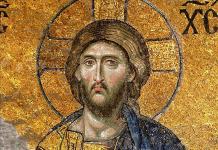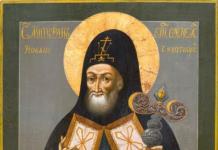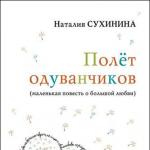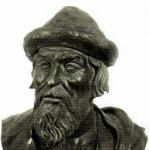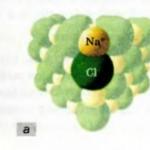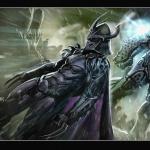Mitrofan of Voronezh is a great saint and wonderworker of the Russian land, who accomplished many good deeds both for Voronezh and for the whole country.
Advice! You can turn to the saint with any request - he stands before the Throne of the Lord and prays for everyone who calls for his intercession.
Prayer for work
O Saint Father Mitrofan, we are sinners, through the incorruption of your honorable relics and the many good deeds miraculously done and performed by you, having become confident, we confess that we have received great grace from the Lord our God, and, humbly falling to your mercy, we pray to you: pray for us, Christ our God, may He bestow His rich mercy on all who honor your holy memory and who diligently resort to you; may she establish in her holy Orthodox Church the living spirit of right faith and piety, the spirit of knowledge and love, the spirit of peace and joy in the Holy Spirit, that all her children, being pure from worldly temptations and carnal lusts and the evil actions of evil spirits, may worship in spirit and truth Let them be diligent in keeping His commandments for the salvation of their souls.
May the Lord give her shepherd holy zeal for the salvation of people, to enlighten the unbelievers, to instruct the ignorant, to bring those who doubt to reason, to return those who have fallen away from the Orthodox Church to her, to keep the faithful in the faith, to move sinners to repentance, to comfort the repentant and to strengthen them in the correction of their lives, and so that all people can be brought to His prepared eternal Kingdom of saints. Pray to the Lord, O servant of Christ: may His faithful servants, in sorrow and sorrow cry out to Him day and night, hear the painful cry and may our belly be delivered from destruction. May our good God grant to all people in the kingdom peace, silence, serenity and an abundance of earthly fruits, and especially to the fulfillment of His commandments, unslothful diligence; and may he deliver the reigning cities, this city and all other cities and towns from famine, cowardice, flood, fire, sword, invasion of foreigners, internecine warfare, deadly plagues and from all evil.
To her, the saint of God, may your prayers arrange all that is good for our souls and bodies; Yes, and we will glorify in our souls and bodies our Lord and God, Jesus Christ, to Him with the Father and the Holy Spirit be glory and power forever and ever. Amen.
Prayer for the life of children
O Saint Father Mitrofan! Accept this small prayer from us, sinful servants of God (names), who come running to you, and with your warm intercession beg our Lord and God, Jesus Christ, that having looked upon us mercifully, He will grant us forgiveness of our voluntary and involuntary sins and deliver us from troubles, sorrows, sorrows and illnesses of soul and body that beset us; may everything contribute to the benefit of our present life; May He grant us to end this temporary life in repentance and may He grant us, sinners and unworthy, His Heavenly Kingdom, to glorify His endless mercy with all the saints, with His Beginningless Father and His Holy and Life-giving Spirit, forever and ever. Amen.
A short prayer to Mitrofan of Voronezh
O Bishop of God, Saint Mitrofan of Christ, hear me, a sinner (name), at this hour, in which I offer you a prayer, and pray for me, a sinner, to the Lord God, may he forgive my sins and grant (the content of the petition) with your holy prayers .
Brief life and prayer help
Baby Mikhail was born in the village of Antipovka, Moscow district, where he grew up and studied science. He later married, and the couple had a son, John. But at the age of 40, his beloved wife departed to the Lord. Mikhail became a widower and decided to take monastic vows. In 1663 he was tonsured a monk and given the name Mitrofan.
 Mitrofan Voronezhsky
Mitrofan Voronezhsky
The monk was strict with himself and with those around him; these qualities played an important role for the abbot of the Yakhroma monastery, who appointed the monk abbot of the monastery.
The saint enjoyed the respect of the brethren, he was especially valued and respected at the royal court of Theodore Alekseevich. The greatest abbot supported many of the undertakings of Peter 1, and was his mentor and teacher.
In 1682, Mitrofan was elevated to the rank of Bishop of Voronezh. At this time, Voronezh residents did not trust the Church of Christ, there was no parish life, people blasphemed God, their level of education was too low. But Saint Mitrofan actively promoted Orthodoxy, erected churches and monasteries within the diocese.
In 1703, the saint fell ill and felt his death approaching and soon died. Emperor Peter 1 was present at his burial and personally carried the coffin with the body of the deceased.
In the Cathedrals of Vladimir, Voronezh, Ivanovo, Kostroma, Lipetsk and Starobelsk (Ukr.) Saints
In the world, Mikhail Vasilyevich, was born on November 6 of the year in the village of Antilokhovo, Kovrovsky district, Vladimir province (now Savinsky district, Ivanovo region) into the pious family of priest Vasily and Maria.
Until the age of 40, the future saint lived in the world, was married, had a son, and served as a parish priest in the village. Sidorovsky, located near the city of Shuya.
The pious and ascetic life of Abbot Mitrofan promoted him to the post of archpastoral service.
Among the constant exploits of his episcopal service, St. Mitrofan approached the coffin. The saint left this world without sorrow; he did not grieve over the separation from earthly joys and pleasures, of which there were few in his ascetic life. He did not lay up treasures on earth. In his cell life he was simple to the point of squalor; his entire household routine was distinguished by exceptional modesty. He ate the simplest food and dressed just as simply. He used all his income for the needs of his diocese and mainly for thanksgiving. After him there was no money left even for burial, although recently the income of the Voronezh saint was considerable. He wrote in his will: “But I don’t have cell money... the imam has neither gold nor silver in his cell to give for the remembrance of my sinful soul.”
The saint’s favorite and constant thought was the thought of death. “Mortal memory”, like a faithful guardian, protected the saint’s heart from attachment to the temporary and perishable, and instilled in him the hope of the eternal. This same constant thought about death also explains the touching feature in the life of the saint - his concern for the commemoration of all those who died an unknown and bitter death, who died in war and in poverty, without repentance and who did not have the opportunity to commemorate themselves.
Prayers
Troparion, tone 4
The rule of faith and the image of meekness / in word and life to your flock, the humble father Mitrofan, was thou. / Moreover, in the brightness of the saints / the brightest sun shone, / crown We adorn incorruption and glory,/ pray to Christ God// our country and your city in the world to be saved.
Kontakion, tone 8
Through self-control the body was enslaved to the spirit, / having created the soul equal to the angel, / you were clothed with the holy robe, like the crown of the priesthood, / and now, before the Master of all, / pray, all-blessed not Mitrofan, // pacify and save our souls.
Prayer
O all-praiseworthy saint of Christ and miracle worker Mitrofan! Accept this small prayer from us sinners who have come running to you, and with your warm intercession, beseech the Lord and our God, Jesus Christ, that having looked upon us mercifully, He will forgive us our sins. forgiveness of both free and unwilling, and in His great mercy He will deliver us from troubles, sorrows, sorrows and illnesses, mental and physical, that support us: may the earth give fruitfulness, and all that is needed for the benefit of our present life: may He grant us to end this temporary life in repentance, and may He grant us, sinners and unworthy, His Heavenly Kingdom, in Let us, together with all the saints, glorify His infinite mercy, with His beginningless Father, and His Holy and Life-giving Spirit, forever and ever. Amen.
Literature
- Edlinsky M., priest. Ascetics and sufferers for the Orthodox faith. and the Holy Russian Land, vol. III, 3rd ed. St. Petersburg, 1903, p. 167-176.
- Vvedensky S. Saint Mitrofan of Voronezh, as a church-state figure in the era of transformation. Voronezh, 1904.
- His Two Episodes to Characterize Morals in Voronezh. Ep. at holy Mitrofane (1682-1703). Voronezh, 1903.
- His question about the delimitation of Voronezh. Ep. from Ryazan at St. Mitrofane. Voronezh, 1903.
- His is Vaska Zheltovsky (an episode from the history of the schism in the Voronezh region under St. Mitrofan).
- Skvortsov G. A. Patr. Adrian, his life and works. Kazan, 1913, p. 111.
- Tolstoy M.V. Stories and I.R.Ts., p. 576, 600-604, approx. 27.
- Poselyanin E. Russian. Church and Russian sub 18th century St. Petersburg, 1905, p. 30, 31, 32.
- Savva, Archbishop Chronicle of my life. Serg. Posad., 1911, vol. IV, p. 163.
- Bulgakov S. Mesyatseslov and Orthodox Triodion. churches, vol. III and IV. Kharkov, 1897, p. 199.
- Macarius, Hierom. Legend about the life of Ave. Makaria, p. 64.
- Filaret, Archbishop. Life of Saint Mitrofan. Voronezh miracle worker. St. Petersburg, 1904.
- Sokolov N. Russian Holy Lands on the 200th anniversary of the death of St. Mitrofan of Voronezh. St. Petersburg, 1903.
- Bulgakov, p. 1398.
- Denisov, s. 102, 172, 173, 329, 463.
- Golubinsky, p. 176-178.
- Ambrose East. Rus. Hierarchies, vol. I, p. 23, 27.
- Stroev P., p. 683, 711, 837, 857.
- Eristov Dictionary of history. about the saints, p. 161-164.
- Chronicle of E. A., p. 688, 787.
- Description of Makariev Unzhen. Kostroma. Ep. husband. m-rya. M., 1835, p. 59, 60.
- The ascetic saints of modern times, glorified in the 18th-19th centuries. M., 1913, p. 85.
- The Life of Mitrofan, in schemamonastic Macarius, the first Bishop of Voronezh and the latter. miracle worker. Kyiv.
- Mitrofan in schema. Macarius, first bishop. Voronezhsky, novoyavl. The Wonderworker and the Legend of the Finding of His Relics, ed. 13th. M., 1896.
- Mitrofan, Saint Voronezh. miracle worker St. Petersburg, 1911.
- Mitrofan, saint, 1st ep. Voronezh. Essay on the life and work of the 200th anniversary of the death of the saint. Voronezh, 1904.
- A word of praise to Saint Mitrofan, the first bishop of Voronezh and miracle worker. Voronezh, 1903.
- Faithful Monthly Book, p. 44, 67.
- Church Vestn., 1891, No. 33, p. 517, 1903, no. 47.
- Right Sobes., 1907, September, p. 394.
- Rus. Palom., 1911, No. 33, p. 522.
- Theologian Vestn., 1897, dep. V, p. 1-20; March, p. 229.
- Arr. to Ts.V., 1903, No. 39, p. 1481-1487; No. 46, p. 1775-1780; No. 47, p. 1819-1823.
- Soulful. Reading, 1897, part 2, p. 530.
- Histor. Vestn., 1885, October, p. 92, 1894, July, p. 220, 1900, January, p. 56, 57.
- Izv. Kazan. Ep., 1885, No. 7, p. 145.
- Rus. antiquity, 1887, July, p. 1, 2, 1904, April, p. 218.
- Rus. archive, 1889, book. 3rd, p. 382, 383 (Stories and anecdotes about Peter the Great), 1895, book. 1st, No. 2, p. 195, 196, 1903, book. 1st, No. 4, p. 539.
- Zh. M. P., 1953, No. 10, p. 22-27.
- J.P.B., vol. VI, p. 81.
- Great Encyclopedia, vol. XIII, p. 230.
- BEL, vol. III, p. 836.
- BES, vol. I, p. 552; vol. II, p. 1574, 1575.
- ES, vol. XIX (book 37), p. 472.
- N.D., p. 61.
Saint Mitrofan was born in 1623 in the Vladimir province. From his will it is known that he was of clergy, had a wife and children and was called Mikhail. Widowed at the age of forty, he entered the Zolotnikovsky monastery near Suzdal, where he was tonsured a monk under the name Mitrofan, and was soon ordained a priest and appointed abbot of the Yakhroma monastery, which he ruled for ten years. Afterwards, Saint Mitrofan was transferred to the Makaryevsky Zheltovodsk Monastery on Unzha, where he stayed for seven years, being loved and revered not only by the brethren, but also by all the surrounding residents, who appreciated his humility, selflessness, hard work and vigilant concern for the organization of the monastery and the construction of a new church in it. .
When the Voronezh diocese was formed in 1682, Saint Mitrofan, personally known to Tsar Feodor Alekseevich, was appointed Bishop of Voronezh and ordained in Moscow, where he was present at the crowning of the kings John and Peter, and also participated in the council in the chambers of the Moscow Kremlin, convened , during the mutiny of the Streltsy, for a dispute with the representative of the new generation of ideologists of the schism, Nikolai Pustosvyat. Arriving in Voronezh, the new bishop zealously set about organizing his diocese, was available to everyone, helped the poor, visited the sick and prisoners in prison, consoled the suffering and addressed the district message to the priests who depended on him, exhorting them and calling on them to serve as an example for the flock not only through preaching and prayer, but also through one’s own life. At this time, Emperor Peter I often visited Voronezh, where the Russian fleet was being built to conquer Azov. Saint Mitrofan, fully sympathizing with this great cause, helped the emperor as much as he could, explained to the people the good intentions of the tsar, collected money for the construction of the fleet and donated his own meager funds for the necessary shipbuilding work. But this devotion of the bishop to the young king did not prevent him from telling Peter the truth in his face and denouncing those actions of the sovereign that were contrary to the rules of piety. The following story vividly depicts the relationship of the Saint to Peter I. The wooden palace that the emperor occupied in Voronezh was decorated on the outside with statues depicting pagan gods. One day, going to the king, Saint Mitrofan saw these statues and returned back. He, offended by this act of the bishop, again sent for him. “Until the sovereign orders the overthrow of the idols that seduce the people, I cannot appear in the palace before his royal eyes,” Saint Mitrofan answered the messenger. The king sent for him three more times, but the answer remained the same. Enraged by this, the emperor ordered to tell the bishop that if he did not immediately appear at the palace, then he, as a disobedient to the royal will, would be executed. “My life is in the power of the king,” answered the bishop, “but for me it is better to die than to violate the duty of the priesthood.” “It is better for me to die than to express my consent with my presence or fearful silence to the installation of pagan fools who seduce the simple hearts of the people.” There was no answer to these words, and Saint Mitrofan, not knowing the final decision of the formidable autocrat, began to prepare for death, and ordered all the bells to be rung, calling the people to the all-night vigil. “What kind of holiday is tomorrow? " asked Peter. “There is none,” they answered him. He sent to ask the bishop about this. “I, as a criminal, have been destined for death by the royal word, and therefore I want to make a conciliar prayer for the forgiveness of my sins, so that the Lord will show His mercy over me.” Immediately, Peter I sent to reassure the Saint and ordered the removal of the statues of pagan gods.
Saint Mitrofan ruled the Voronezh diocese for twenty years. Before his death, he accepted the schema and died quietly on November 23, 1703. Peter the Great, having learned about the illness of the holy elder, hastened to him and arrived in Voronezh on the very day of his death, but no longer found him alive. He closed his eyes and himself carried the Saint’s coffin to his grave. Saint Mitrofan left a will in which he gives wise advice to his flock and asks them to pray for the salvation of his soul. The residents of Voronezh fulfilled his wish, they served memorial services at his grave, asking for his prayers in illness and misfortune, and by faith they received healing from their ailments and consolation in sorrow. The relics of St. Mitrofan, soon after the canonization of the Saint by the Most Holy Synod, were discovered in 1832 and placed in the Mitrofanevsky Monastery.
About the spiritual testament of Saint Mitrofan
Anticipating in his soul and body the approach of the hour of death, Saint Mitrofan prepared an extensive spiritual testament: “Remembering death, I decided to write my last scripture, as if to create fruit for my soul and body.”
The will introduces us to the dying thoughts, feelings and last orders of Bishop Mitrofan. Not a single word, not a single hint reveals in the Saint the fear of mortals or regret about the abandonment of earthly blessings, which he had long ago renounced. He left the earthly world with a calm conscience, with the awareness of his duty fulfilled and with deep hope in the mercy of God. The saint’s heart was full of deep gratitude to God, “by whose grace he was born into the world and reached old age,” and gratitude to the people around him, to all of them he bequeathed from himself “peace and prosperity and forgiveness.”
At the beginning of the Testament, the Saint confesses his faith to everyone, briefly outlines the main stages of his life; gives private orders: about the place of burial and funeral vestments, about the departure of the magpie and about the annual commemoration. “Do mercy,” the saint asks, “do not disobey us, but fulfill us in everything.”
The rest of the will consists of an exhortation to the clergy to live piously, holyly and decently. “Honorable priests of the Most High God! Leaders of the verbal flock of Christ! You must have bright eyes of mind, enlightened by the light of understanding, in order to lead others along the right path; according to the word of the Lord, you must be the very light... teach people the word of teaching, set an example of a good life, diligently offer prayers to God for the flock entrusted to you.”
The saint teaches all Orthodox Christians wise rules of life, calls for the unshakable preservation of faith and for unswerving adherence to the teachings of the Church of Christ. “Otherwise, the rule of wise men to every person is: use labor, keep moderation: you will be rich; drink abstinently, eat little: you will be healthy; do good, run gold: you will be saved. ...May all Orthodox Christians abide in their ancestral piety, righteousness, in all goodness, in purity, in abstinence, and holiness, and repentance... For without right faith it is impossible to please God: so also except the Holy Church It is impossible for anyone to be saved by the Eastern and bright God-given teachings.”
The saint advises to be especially careful when dealing with people of other faiths, of whom there were many in Voronezh at that time during the construction of the Fleet. “Many infidels: Luthers, Calvins and Latvians are unwise, and Christians are also leaders of wolves over lambs, and they commit every insult to the poor... The saint reminds us that both now and in ancient times” the infidels were of little use, for they are obvious enemies of the Church and all Orthodox Christians. He calls on the flock not to accept “foreign obscene customs” and not to listen to “their flattering false teachings,” but to strengthen themselves in the fatherly faith, recalling the words of the Apostle: “Do not be carried about by every wind” (Bphess. 4:14).
In the final part of his will, the Saint once again humbly asks all people of “every rank and age of our diocese” for forgiveness and leaves his bishop’s blessing to all of them. “I entrust myself, a sinner, to God himself to the mercy and shameless intercession of my Lady, the Most Holy Virgin Mary, and to my Guardian Angel and all the saints, pleasing to God, with prayers, crying and saying to God our Heavenly Father: “Father! I commend my spirit into Your hands. Amen...."
Miracles and the discovery of the relics of St. Mitrofan, chief priest of Voronezh
St. Mitrophan's behests to his flock to pray for the repose of his soul were not forgotten by her. The image of a loving and merciful bishop was deeply etched into the soul of the people, sensitive to manifestations of holiness on a sinful earth, and many reverent admirers of the memory of the deceased saint flocked to his grave to serve a requiem mass. The generation of witnesses to the pious life of the First Throne of Voronezh was replaced by another, but the memory of him did not weaken; The ranks of those praying at the saint’s tomb did not thin out, but increased, where many, through his prayerful intercession before the Lord, received miraculous help. Soon the Lord, fulfilling the pious aspirations of the admirers of St. Mitrofan, as a saint of God, laid the foundation for his open glorification.
The Cathedral Church of the Annunciation, created by the labors of St. Mitrofan, began to collapse around 1717. The cathedral had to be broken down in order to use its material to build a new one, which was laid on a stronger foundation and in a place that did not threaten the integrity of the building. The work began in 1718, and at the same time the coffin with the body of St. Mitrofan from the lower chamber of the Archangel chapel, which was also significantly damaged, by order of Bishop Pachomius of Voronezh, was transferred to the church in honor of the icon of the Mother of God “The Burning Bush,” under the wooden cathedral bell tower. Upon completion of construction, in 1735, the body of St. Mitrofan was transferred to the new cathedral and buried “in the right wing of the cathedral, near the southernmost wall, in the highest first place, towards the corner.” During both transfers, the body of the saint turned out to be incorrupt, so that the conviction of the holiness of the deceased primate of Voronezh was finally strengthened, and reverent veneration of his memory began to spread wider and wider across the face of the Russian land.
On the history of the first image of the Saint
In 1830, the Voronezh merchant Gardenin, who experienced the gracious help of St. Mitrofan and revered him as a great saint of God, found a very old portrait of the First See of Voronezh. Wanting to have an image of the Saint, Gardenin turned to the amateur artist Shvetsov to make a copy of the portrait. But the portrait was so dilapidated that it was difficult to discern the features erased by time. Fearing to distort the face of the great Saint, Shvetsov refused to fulfill Gardenin’s request. Shvetsov’s decision could not be changed by the convictions of Voronezh Bishop Anthony (Smirnitsky), who also wanted to have an image of the High Hierarch of Voronezh, whose memory he reverently honored. Once, Vladyka Anthony, after futile efforts to convince Shvetsov, told him with deep confidence:
Do not doubt: you will see the Saint in reality or in a dream.
Shvetsov believed the words of the pious Bishop Anthony and spent that entire day in prayer to God, so that He would grant him the opportunity to see St. Mitrofan. And so, the very next night Shvetsov saw the old man in a dream, but only in the dark, it was unclear, then the light dispelled the darkness.
When Shvetsov woke up, the image of the Saint was so vividly imprinted on his soul that he easily reproduced it from memory on canvas. Then he told Eminence Anthony about the miraculous appearance of Saint Mitrofan and showed him the image he had drawn. The Bishop blessed Shvetsov to paint copies of this image, keeping in mind the desire of many admirers of the memory of the First Throne of Voronezh.
The fate of the relics of St. Mitrophan of Voronezh in the 20th century
With the advent of the godless government, the Voronezh Mitrofan Monastery, like many Russian shrines, suffered devastation: it was closed, looted, and then demolished. The shrines stored in it were desecrated, some were destroyed; the monastics were dispersed and sent to prison; They repeatedly tried to fill up even the consecrated spring located in the monastery. But, to the surprise of everyone, each time he again made his way through the ground not far from the previous place, signifying that the spiritual spring could not be drowned out. Now it flows under the mountain on which the Mitrofan Monastery stood.
Popular legend has preserved some details of the mockery committed over the honest relics of St. Mitrofan. On February 3 (new style), 1919, before the start of the Liturgy, the leaders of the local Bolshevik cell, accompanied by a large crowd of Red Army soldiers and security officers, entered the Annunciation Cathedral of the Mitrofanovsky Monastery. They announced to the clergy, the brethren of the monastery and numerous pilgrims the decision of the “working people” - “to put an end to the priest’s fables about holy relics.”
The Red Army soldiers pushed the believers away from the large shrine of the saint and took out the cypress shrine containing the relics. The proposal to the clergy to extract the relics was rejected by him. The atheists mockingly began to pull off the robes from the holy relics, completely exposing them. At the same time, the people were shown objects that were not related to the relics, specially brought by the Bolsheviks for anti-religious propaganda. Then, for public viewing, the holy relics were raised on bayonets.
The monastery brethren and pilgrims cried, unable to stop the lawlessness. Hegumen Vladimir reassured them: “The great mercy of God was shown to the saint at the end of his earthly life - to endure martyrdom for Christ.” Having committed the desecration, the atheists drew up an autopsy report. They included the honorable remains of Saint Mitrofan in the inventory of property as “socialist property” and left them in the cathedral.
The revelation did not take place. The monstrous blasphemy of the Bolsheviks only increased the influx of believers to Saint Mitrofan, and their prayer became more fervent. But the lawless people did not calm down; they began to act more sophisticatedly. In 1922, the Bolsheviks initiated a schism in the Orthodox Church. The Annunciation Cathedral (the monastery was already closed by that time) and the relics of the saint located in it ended up in the hands of schismatic renovationists. His Holiness Patriarch Tikhon excommunicated the Renovationists from the Church. Orthodox believers, according to the plan of the atheists, had to either stop venerating the holy relics, or join the “official” Renovationist Church. Orthodox Voronezh residents found themselves in a difficult situation. But Orthodox priests from church pulpits declared how one should behave correctly: one cannot be baptized in Renovationist churches, all their sacraments are graceless, their “holy” water is not holy, but icons, and especially such a great shrine as the relics of the saint of God, are preserved grace while in captivity among schismatics. Renovation churches were empty; The treasury of the renovationist Annunciation Cathedral was empty. But the influx of worshipers to the holy relics captivated in it did not weaken.
In 1926, more than twenty thousand pilgrims and pilgrims from different places of the Voronezh province visited St. Mitrofan. In this regard, all district Councils of atheists were given a directive “to organize a mass round of peasant huts with a proposal to donate to the defense of the USSR those funds that are supposed to be used for pilgrimage.” On August 20, 1927, more than thirty thousand rural pilgrims and more than forty thousand city dwellers came to Saint Mitrofan.
But the provincial party committee did not weaken its pressure on the great prayer book of Voronezh. It was decided to hold a “Mitrofan’s Day” on the day of the glorification of the godless saint, organizing a Komsomol festivities on the cathedral square, with the involvement of club circles, circus and orchestral groups.
In 1929, seeing the futility of their struggle with the holy saint of God, the authorities decided to “liquidate the hotbed of superstition and mysticism, which is holding back the development of class consciousness, preventing the introduction of new, socialist rituals.” They acted insidiously, mocking the feelings of believers. Traditionally, on August 20, several tens of thousands of pilgrims flocked to the Annunciation Cathedral. Unexpectedly for everyone, religious services were prohibited. Local atheists and party leader Vareikis arrived at the cathedral and announced that the relics of St. Mitrophan of Voronezh were being confiscated due to the closure of the cathedral to be used for the needs of socialist construction. The relics of the saint were taken away. It was announced to the pilgrims that they could join the Komsomol celebration. Until late in the evening, the sounds of revolutionary marches could be heard in the square in front of the cathedral. For this purpose, all five brass bands available in Voronezh were involved.
Orthodox Voronezh residents grieved the loss of a great shrine - a blessed source of miracles, and were saddened by the offensive mockery of the communists. And for the honest remains of St. Mitrofan, a new captivity began - now in the Voronezh Museum of Local Lore, where the atheists placed them. This captivity lasted six decades.
Under the conditions then existing, it was impossible to think about the return of the great shrine. The atheistic state did not abandon its plans to completely destroy the Russian Orthodox Church. Some hope for the return of the holy relics of the first Voronezh Bishop Mitrofan appeared after the Great Patriotic War.
On September 4, 1946, Archbishop Joseph (Orekhov) of Voronezh and Ostrogozh filed a petition with the civil authorities for the return to believers of the relics of the saint located in the museum. The authorities began to consider the feasibility of their return. A year later, the Bishop of Voronezh, through His Holiness the Patriarch, appeals to the Soviet government in the hope of finding a shrine for the coming 1953, the anniversary of the saint. But there was a refusal from the authorities, and Saint Mitrofan was not released from captivity.
The 250th anniversary of the saint was solemnly celebrated in all parishes of the Voronezh diocese. At the end of the Divine Liturgy, in the St. Nicholas Church in Voronezh, a festive reading was held for the clergy and laity. Those present were acquainted with the saintly and patriotic activities of the first Voronezh bishop. In his word, Archbishop Joseph said: “Although we are now separated from the incorruptible flesh of our saint, we were not separated from him in spirit, and our prayer to him did not weaken. On days of holidays and in days of adversity, we always turn to him: “The chosen miracle worker and great servant of Christ, the multi-healing source and prayer book for our souls, the holy hierarch Father Mitrofan, as having boldness towards the Lord, free us from all our troubles, calling: Rejoice Mitrofan, great and glorious miracle worker.”
A real triumph of Orthodoxy was the celebration on September 16-17, 1989 of the return to the Russian Orthodox Church of the relics of the saint and wonderworker Mitrofan of Voronezh, accomplished by the grace of God and the labors of Metropolitan Methodius of Voronezh and Lipetsk.
The archbishops of Saratov and Volgograd Pimen (†1993), Ryazan and Kasimov Simon (now Metropolitan), Bishop Niphon of Philippopolis, representative of the Patriarch of Antioch to the Patriarch of Moscow, rector of the Leningrad Theological Schools Archpriest Vladimir Sorokin, abbot of the St. John the Theological Monastery in the Ryazan Diocese, arrived for the holiday Archimandrite Abel, many clergy and believers. Local television and radio announced the upcoming celebrations in advance, and the entire city, the entire diocese participated in this significant event.
On September 16, before the all-night vigil, on one of the streets close to the Intercession Cathedral, the reliquary with holy relics was greeted by a procession of believers with a council of bishops and a host of clergy. The road was covered with fresh flowers, several thousand people with tears in their eyes and with lit candles were waiting for the shrine, and the bell from the cathedral announced to the whole city about the return of its primate, who in his time often called Voronezh “the House of the Most Pure One.” The reliquary with holy relics, covered with an ancient shroud, was placed in the altar of the Intercession Cathedral on a high place.
During the singing of “Praise the name of the Lord,” the shrine with the relics of the saint of God is placed in a specially prepared place in the middle of the temple. The glorification of the saint has a special sound. The veil is removed. The worshipers see a cypress shrine, in which the holy relics have been lying since the discovery. There were so many people wanting to get into the church that there was no room even in the courtyard, and people stood in the pre-cathedral square and listened to the service through amplifiers.
The cathedral was open all night. The people approached the holy relics, the clergy anointed the pilgrims with consecrated oil, akathists were read, and confession was conducted.
The late Liturgy was performed by the same right-Reverend bishops. The jubilant people greeted with gratitude Metropolitan Methodius of Voronezh and Lipetsk, who had worked so hard to return the relics of his holy predecessor. After the solemn prayer service, a special prayer was read, composed by Archbishop Anthony (Smirnitsky) before the discovery of the relics of St. Mitrofan in 1832, in which the blessing of the saint of God was requested for the transfer of his sacred remains. The shrine with the relics of the saint was solemnly installed in the prepared place.
Metropolitan Methodius warmly congratulated the guests and flock on the holiday, noting that the opening of churches, monasteries, and the return of shrines to the Russian Orthodox Church is a sign of our time and has not only church, but also national significance.
On behalf of the bishops participating in the celebration, Archbishop Pimen warmly congratulated His Eminence Methodius on the significant event and wished that everyone would love our Lord and each other, like St. Mitrofan. His Grace Bishop Niphon conveyed to those gathered the blessing of the Primate of the Antiochian Church. After the Divine Liturgy, a gala reception was held for guests and participants of the celebration, which was attended by representatives of local authorities.
Since then, the relics of St. Mitrofan have remained in the Intercession Cathedral of Voronezh, being an imperishable testimony to the truth of Orthodoxy and teaching great consolation and help to all who come with faith. There are many known cases of miracles occurring among them today.
Every Sunday, before the relics, a water prayer service is performed with all the people singing an akathist to the great saint of the Church of Christ and the heavenly patron of the city of Voronezh.
Saint Mitrofan, the first bishop of Voronezh, was born on November 6, 1623 in the Vladimir land, presumably into the family of a priest. The worldly name of the future saint was Michael. The saint lived half of his life in the world, was married and had children. Information has been preserved about the care of Saint Mitrofan in raising his son Ivan. The future bishop was for some time a priest in the village of Sidorovskoye, Suzdal diocese. At the age of 40, he became a widower and decided to devote his life to God. He chose the Zolotnikovsky Assumption Monastery not far from Suzdal as his place of residence, where he was tonsured a monk with the name Mitrofan.
Here the saint of God began his monastic asceticism, distinguished by deep humility. His strict monastic life became known among the monastic community. Three years after entering the Zolotnikovsky monastery, the brethren of the neighboring Yakhroma Kosmin monastery, which did not have an abbot at that time, began to ask the local spiritual authorities to bring Mitrofan to them as abbot. The request was fulfilled. At first, the ascetic was ordained to the priesthood, then, despite his reluctance, he was elevated to abbot of the Yakhroma monastery.
When Patriarch Joachim of Moscow and All Rus' learned about the ascetic’s zeal, he entrusted him with the larger Unzhensky monastery, founded in the 15th century. Venerable Macarius of Zheltovodsk in Kostroma land. Here the future saint abboted for about seven years, during which the monastery achieved prosperity. A temple was built in honor of the Annunciation of the Blessed Virgin Mary, and many wonderful icons were painted.
The monastery of Abbot Mitrofan attracted the attention of not only the Patriarch, but also Tsar Theodore Alekseevich, who visited the monastery and often talked with the abbot. At court the saint was treated with special respect. When in 1682, by decision of the Moscow Church Council of 1681, the new Voronezh diocese was formed, Tsar Theodore proposed to appoint Abbot Mitrofan as its first bishop. The episcopal consecration on April 2, 1682 was led by Patriarch Joachim.
Saint Mitrofan had to witness the riot of schismatics in July of the same year and attend the “debate about faith” between the Old Believers and the Orthodox in the Faceted Chamber. This event made a strong impression on him and subsequently affected his episcopal affairs. Saint Mitrofan gained fame as an exposer of the schism and a supporter of the patriotic endeavors of the reformer tsar. Saint Mitrophan considered the clergy as a force capable of influencing the population in the most beneficial way. At the very beginning of his activity, the saint began to build a new stone church in Voronezh in honor of the Annunciation of the Most Holy Theotokos. Saint Mitrofan loved church splendor and invested enormous amounts of money in the construction of the cathedral. The life of the saint was more than modest.
A special page in the biography of Saint Mitrofan is his relationship with Peter I. The saint deeply and sympathetically entered into the fate of the young Tsar, and tried to promote the transformations that arose that were beneficial for the Fatherland. He approved of the construction of the fleet undertaken by Peter I in Voronezh and supported it financially. When in 1696 Russian troops won a victory over the Turks near Azov, Peter I ordered Saint Mitrofan, as if as a reward for his participation in this victory, to be called Bishop of Voronezh and “Azov”. At the same time, Saint Mitrofan could not approve of the tsar’s too close communication with foreign infidels and thoughtless acceptance of their customs. The saint refused to visit the Tsar's Voronezh palace because of the pagan statues that were in it. When the angry Peter began to threaten him with death, the saint began to prepare for it, preferring to die rather than approve pagan rituals unacceptable for an Orthodox person.
The bishop's confession put Peter to shame; as a sign of agreement with him, he removed the statues, and peace was restored. The saint of God remained at the Voronezh pulpit for 20 years, until his death.
The saint’s favorite reflection was the remembrance of death, the afterlife, and ordeals; favorite prayer is the prayer for the dead.
Not being familiar with the widespread in the 17th century. Latin scholasticism, Saint Mitrophan knew the Holy Scriptures and patristic works very well. In his “Spiritual Testament,” Saint Mitrophan edified: “For every person, this is the rule of wise men: use labor, maintain moderation, and you will be rich; drink abstinently, eat little - you will be healthy; do good, flee evil - you will be saved.” Saint Mitrofan reposed before God in 1703 at a ripe old age. Shortly before his death, the saint accepted the schema with the name Macarius. He was buried in the Annunciation Cathedral in Voronezh with great honors: the tsar with his own hands helped to carry the coffin of the saint, whom he revered as a “holy elder.”
Since 1820, the number of admirers of the prayerful memory of St. Mitrophan has especially increased, and records of miracles at his tomb began to appear at the cathedral. In 1831, there was an official report about this to the Synod, according to which, on August 7, 1832, the solemn opening of the coffin took place, and then the canonization of the saint followed. From his holy relics, by the grace of God, numerous healings took place for those suffering from physical and mental ailments, the possessed, and the paralytic. In 1836, the Annunciation Mitrofan Monastery was established at the Annunciation Cathedral in Voronezh.
During his lifetime, Mitrofan became famous for his great compassion, mercy, kindness and, even being in the rank of Bishop of Voronezh, he was accessible to both dignitaries and ordinary people. Saint Mitrofan helped the poor and disadvantaged, visited the sick in hospitals, admonished prisoners in prison, and consoled the suffering. His house was a refuge for orphans and the poor. The pious elder was a great righteous man who committed many good deeds. From one touch to his clothes, miraculous healings of seriously ill people occurred.
In November, the sixth day of 1623, in the Vladimir province a baby was born into the family of a priest. The boy was named Mikhail and was raised in the spirit of Orthodox traditions in love for the Lord. Mikhail grew up as an exemplary God-fearing child and studied well at school. After training, he married and was appointed a priest in the village of Sidorovskoye. Father Mikhail had a son, John, and was known as a caring husband and loving father. By the age of forty, he was widowed, had a hard time with the death of his wife and decided to take monastic vows.
He settled in the Zolotnikovsky Monastery and renounced this world. In 1663 he took monastic vows and was named Mitrofan. The novice Mitrofan was strict with himself and those around him, and enjoyed the respect and love of all the brethren. In 1665 he was elevated to the rank of abbot at the Yakhroma monastery. Here he served as rector for 10 years. In 1675, Mitrofan became rector of the Unzhensk monastery and ruled it for almost 7 years. During the years of his reign, the Unzhensky Monastery achieved its prosperity.
 Emperor Fyodor Alekseevich (Romanov) often visited the monastery and often talked with the abbot. At court, Abbot Mitrofan was treated with respect. In 1682, Tsar Fyodor Alekseevich recommended appointing Abbot Mitrofan as bishop to the newly formed Voronezh diocese
Emperor Fyodor Alekseevich (Romanov) often visited the monastery and often talked with the abbot. At court, Abbot Mitrofan was treated with respect. In 1682, Tsar Fyodor Alekseevich recommended appointing Abbot Mitrofan as bishop to the newly formed Voronezh diocese
The newly appointed bishop was concerned in every possible way about the well-being and organization of church life, as well as about the welfare of the state. In those days, many Christians bore pagan names, drank, and lived in vice. Church attendance was very rare. The region required constant work and expenses to improve the church structure. Bishop Mitrofan understood this well. In Voronezh, the Annunciation Cathedral was erected in honor of the Blessed Virgin Mary. In 1692, the cathedral was consecrated and it became a favorite place for parishioners.
 Bishop of Voronezh was known as a strict but fair archpastor. He preached a lot, did charity work, and organized schools that taught literacy and theology. Having large incomes, he distributed all the money to those in need, while living very modestly.
Bishop of Voronezh was known as a strict but fair archpastor. He preached a lot, did charity work, and organized schools that taught literacy and theology. Having large incomes, he distributed all the money to those in need, while living very modestly.
A special relationship developed between the bishop and Emperor Peter the Great. Vladyka Mitrofan supported many of the young monarch’s endeavors and was his teacher and mentor. He helped Peter organize shipbuilding in Voronezh for the construction of a fleet. The tsar treated the bishop with great respect and even, at his request, reduced duties from some monasteries.
In 1703, at the age of eighty, the pious elder became seriously ill. A few years before his death The saint left a spiritual testament:
- Pray for the dead;
- Maintain peace among yourself;
- Honor those in power;
- Keep the Lord's commandments.
Before his death, the bishop wished to accept the schema. On August 10 he was tonsured and named Macarius. On November 23, 1703, Mitrofan died quietly. The bishop was buried in the Annunciation Church in Voronezh. In 1832, Mitrofan of Voronezh was canonized among the saints of God.
Relics of the saint
 During the renovation of the cathedral, the relics of the Holy Wonderworker were transferred twice, and each time it was their incorruptibility is attested. Even after the death of the elder, his relics retained the gift of miraculous healing.
During the renovation of the cathedral, the relics of the Holy Wonderworker were transferred twice, and each time it was their incorruptibility is attested. Even after the death of the elder, his relics retained the gift of miraculous healing.
With the coming to power of the atheists, many monasteries and temples were looted, destroyed and demolished. The Annunciation Cathedral was also damaged. The relics of the saints stored in it were destroyed. They tried to fill up the healing spring located in the monastery many times, but each time it found its way through a layer of earth. The relics of St. Mitrofan were preserved and transferred to the local history museum, where they remained for 60 years.
In 1989, the relics of the Wonderworker of Voronezh were returned to the Orthodox Church. On September 16, the holy relics, covered with an ancient shroud, were placed in the altar of the Intercession Cathedral in Voronezh in the prepared place. They, as before, continue to heal the sick and suffering. Christians from all over the world make a pilgrimage to this place.
Prayers to Mitrofan
Before the icon of the saint, parishioners pray:
- About help in finding a job;
- About creating a family for children;
- About the well-being of the son;
- About healing a sick soul;
- About getting rid of poverty;
- About receiving a promotion;
- About receiving God's forgiveness and mercy.
 When presenting his petition to the saint, the believer must read the holy text sincerely, with all his heart. For prayer to be heard, you must follow simple rules:
When presenting his petition to the saint, the believer must read the holy text sincerely, with all his heart. For prayer to be heard, you must follow simple rules:
- Say the prayer without any pretense;
- When praying, you should think about the request and not be distracted by extraneous thoughts;
- The words of the prayer are pronounced calmly in a quiet voice;
- A prayer read simply out of obligation will not bring any benefit and may anger the saint;
- It is no good to ask for material benefits;
- It is necessary to visit the temple, cleanse yourself of sins and prepare for prayer.
Prayer to Mitrofan of Voronezh about work
O holy Father Mitrofan! Accept this prayer from us, sinful servants of God (names), who come running to you, and with your warm intercession, beg our Lord, Jesus Christ, to grant us forgiveness of our sins and deliver us from sorrows and troubles, from sorrow and illnesses of soul and body , tormenting us. Let us give everything we need for the benefit of our present life; and grant us this temporary repentance at the end of our lives and may we, unworthy and sinful, be worthy of His Heavenly Kingdom, and with all the saints, to glorify His infinite mercy, with His Beginning Father and His Life-giving Holy Spirit, forever and ever.
Prayer for the life of children
O holy Father Mitrofan, by the incorruption of your miraculous relics and the good deeds done and created by you, bestowed upon you with faith, having become confident in your grace from our Lord, we all humbly fall down and pray to you: pray for us to our God, Jesus Christ, to send to all who honor Your holy memory and who diligently resort to You, Your rich mercies.
May He establish a living spirit, right faith and piety in His holy Orthodox Church. The Spirit of peace and love and joy in the Holy Spirit, that all its members are clean from carnal lusts and worldly temptations and the actions of evil spirits, worship Him in truth and spirit and care about keeping all His commandments for the salvation of their souls. May your shepherds be given holy zeal to care for the salvation of the souls of the people entrusted to them, may they enlighten the unbelievers, instruct the ignorant, enlighten those who doubt, and convert those who have fallen away from the Orthodox Church into its holy bosom.
Believers will be kept in faith, sinners will be moved to repentance, those who repent will be strengthened and consoled in the correction of life, those who have reformed and repented will be confirmed in the holiness of life: and they will also lead everyone along the path indicated by God into His eternal kingdom prepared for all. Holy Hierarch of God, may your prayers have provided all the good to our souls and bodies: may we glorify in our souls and bodies the Lord our God, Jesus Christ, His Father and the Holy Spirit, from now on and forever and ever. Amen.
Legacy of the Voronezh Wonderworker
 Many churches were built in honor of St. Mitrofan and monasteries throughout Russia. Following the example of the great miracle worker and benefactor, Sunday schools, various clubs, and teenage clubs were organized in church institutions. Many parishes provide assistance to low-income parishioners. Charity groups have been created at churches. They provide care for seriously ill and elderly lonely people.
Many churches were built in honor of St. Mitrofan and monasteries throughout Russia. Following the example of the great miracle worker and benefactor, Sunday schools, various clubs, and teenage clubs were organized in church institutions. Many parishes provide assistance to low-income parishioners. Charity groups have been created at churches. They provide care for seriously ill and elderly lonely people.
Orthodox educational institutions were created (at the Church of the Annunciation of the Blessed Virgin Mary in Petrovsky Park). In Voronezh there is an Orthodox gymnasium named after Mitrofan of Voronezh. Museums are opened in parishes and monasteries, Orthodox magazines are published, and there are church libraries (the Church of the Icon of the Sign of the Mother of God in Kuntsevo).
Archbishop Mitrofan showed the entire Christian world an example of not only spiritual life, but also image of a true Orthodox Christian striving for the good of his people and fatherland. He managed to remain faithful to his heavenly Lord and earthly king.
